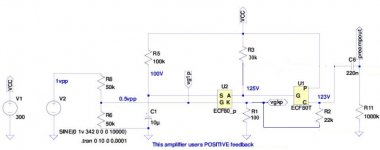Finally I got the LTSPICE working, in my computer (UNIX), and could play with some cirtuits using tubes. I manage to develop a preamp with only ONE tube (ecf80) that gives a voltage gain greater than 300. The solution is to use kind of bootstrap to generate a constant current load in the anode of the pentode, so its gain raises from 46 (manual) to more than 300.. The spice model say it works.
Attachments
Why do you need such high gain?I manage to develop a preamp with only ONE tube (ecf80) that gives a voltage gain greater than 300.
Finally I got the LTSPICE working, in my computer (UNIX), and could play with some cirtuits using tubes. I manage to develop a preamp with only ONE tube (ecf80) that gives a voltage gain greater than 300. The solution is to use kind of bootstrap to generate a constant current load in the anode of the pentode, so its gain raises from 46 (manual) to more than 300.. The spice model say it works.
It works, but what about parasitic capacitances and bandwidth?
Why shout "POSITIVE"? Have you only just realised that bootstrapping is a form of positive feedback?
Bootstrapping a pentode load is likely to increase distortion (unlike a triode).
Bootstrapping a pentode load is likely to increase distortion (unlike a triode).
Gary Pimm has tested quite a number of pentodes using a CCS in parallel with a large resistor (because the pentode behaves itself like CCS and so it cannot work with an "infinite" load) and they all provide high-to-huge voltage swings with very low distortion. Of course the parallel plate resistor doesn't necessarily need to be in parallel with the CCS but it can be the usual grid resistor of the next stage. How much distortion really depends on how linear a device is, the operating point etc. Nothing really different from usual.
Those pentodes tested by Pimm are generally better than most triodes in terms of distortion....
As Wavwebourn said I would check the high frequency response in a real case where the driven stage has an additional input capacitance itself and there are other parasitic capacitances.
FR is decent as is but it might get quite worse.
Those pentodes tested by Pimm are generally better than most triodes in terms of distortion....
As Wavwebourn said I would check the high frequency response in a real case where the driven stage has an additional input capacitance itself and there are other parasitic capacitances.
FR is decent as is but it might get quite worse.
- Status
- Not open for further replies.
